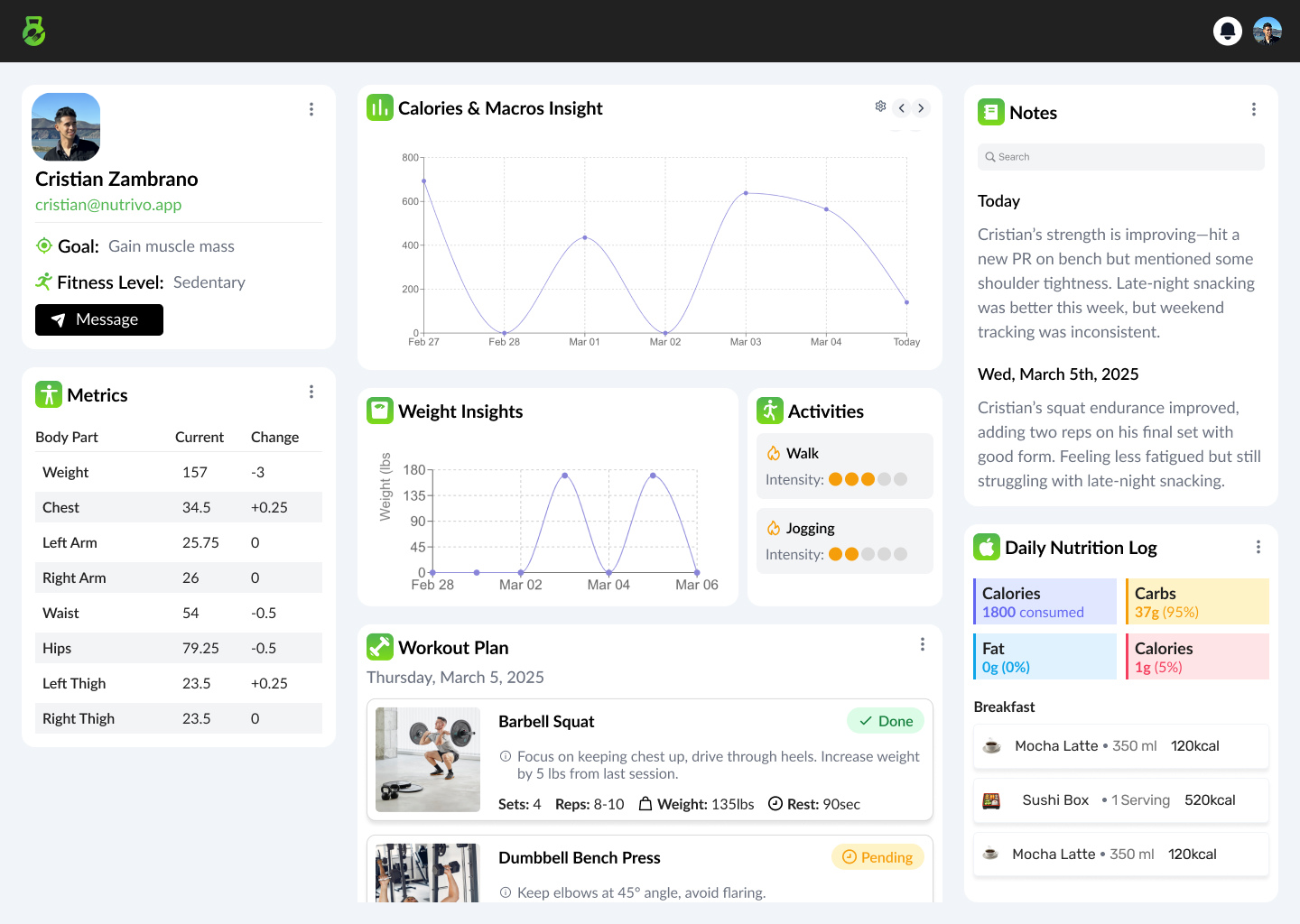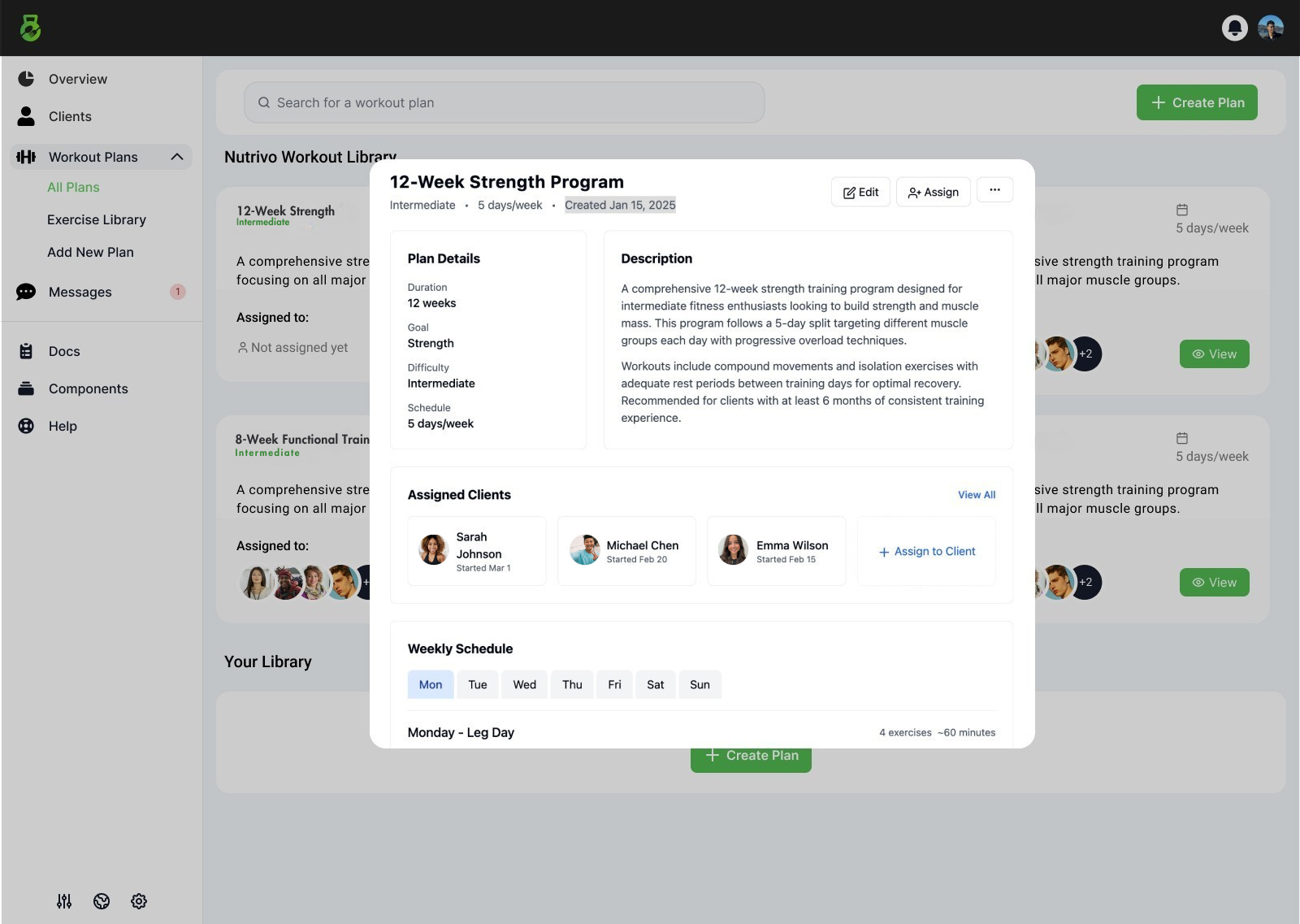![[object Object]'s avatar](/_next/image?url=https%3A%2F%2Ffirebasestorage.googleapis.com%2Fv0%2Fb%2Fnutrivo-45161.appspot.com%2Fo%2Fimages%252Favatars%252Fmemoji-3.webp%3Falt%3Dmedia%26token%3D28a92f7e-ddce-492c-a4b4-783036511c75&w=256&q=75)
How to Write a Fitness Program Clients Actually Stick To (2025 Guide)
Your Perfect Program is Killing Client Results

That sentence might seem counterintuitive, especially if you've spent years perfecting your exercise science knowledge. But the painful truth is that even the most meticulously designed workout program is meaningless if clients don’t actually follow it.
Of course, each client’s situation is unique. A professional powerlifter training for peak performance requires a rigorous and highly specialized regimen. However, for the average individual seeking general fitness, the focus should shift from optimizing complexity to ensuring long-term adherence. Without consistency, even the best program won’t yield lasting results
Research consistently shows that exercise adherence rates vary widely depending on the program and individual factors. On average, only about half of people who start an exercise program maintain consistent participation over time. A meta-analysis found that just 54% of people who intended to exercise actually followed through, and other studies report that approximately 50% of individuals stop their aerobic exercise program within the first six months..
But it doesn't have to be this way.
Here's how to design programs clients will actually stick with, driving better results, higher satisfaction, and dramatically improved retention.
Why "Perfect" Programs Fail (The Adherence Paradox)

Before diving into solutions, we need to understand a critical concept: the Perfect Program Paradox.
The paradox goes like this: The more "optimal" and comprehensive a program becomes from an exercise science perspective, the less likely clients are to actually complete it consistently.
Why? Because optimization typically means:
- Longer, more complex workouts
- Higher intensity requirements
- More technical exercises
- Stricter scheduling demands
Each of these factors increases what behavioral scientists call the "friction cost" of adherence—essentially making it psychologically harder for clients to follow through, especially when life gets busy or motivation dips.
Three Common Program Design Mistakes That Kill Adherence
In my work as a trainer and co-founder at Nutrivo, I've identified three critical mistakes that sabotage client consistency before they even begin:
Mistake #1: Starting Too Intense
Many trainers design programs at 90-100% of what they think a client can handle. The reasoning makes sense: challenge them to maximize results. The problem? This approach frontloads the difficulty when habits aren't yet established, leading to early dropout.
Mistake #2: Focusing Only on Physical Metrics
When programs track only weight, measurements, or strength gains, clients lose motivation during inevitable plateaus. The exclusive focus on physical outcomes creates an "all-or-nothing" mindset where anything short of visible progress feels like failure.
Mistake #3: Inconsistent Feedback Loops
Most programs lack strategically timed check-ins and celebrations, missing key psychological triggers that reinforce consistency. This is something I discussed in detail in our neuroscience hacks for trainers blog, but it bears repeating: the brain needs regular wins to stay engaged.
The 70% Rule: Building Momentum Through Achievable Success

The foundation of any "sticky" program is what I call the 70% Rule, a principle that transforms how clients experience your programming from day one.
Here's how it works: For the first two weeks of any new program, design workouts at approximately 70% of what you believe the client could handle at maximum effort.
This isn't about creating easy workouts—it's about strategically building what psychologists call "self-efficacy," the client's belief in their ability to succeed at fitness tasks.
Implementing the 70% Rule:
Assess realistically: If you think a client could handle 4 weekly workouts at 60 minutes each, start with 3 weekly workouts at 45 minutes.
Include familiar movements: Begin with exercises the client already knows and feels confident performing, gradually introducing new movements.
Build in quick wins: Ensure clients experience success in every session by including at least one element they can measurably improve at each week.
Gradually progress: After the initial two weeks, increase intensity by approximately 10% if adherence has been strong.
Remember, the goal of the first two weeks isn't maximum physical adaptation—it's establishing the consistent habit of showing up and completing workouts. The physiological adaptations will follow once the behavioral foundation is solid.
Visibility Creates Accountability: The Tracking Revolution
The second pillar of creating "sticky" programs is implementing robust visibility systems. Simply put: what gets tracked gets done.
But effective tracking goes far beyond simply checking off workouts—it creates a psychological commitment mechanism that dramatically increases follow-through.
Effective Tracking Implementation:
Make it unavoidable: Choose tracking methods that clients interact with daily, not just during workouts.
Track beyond physical metrics: Include subjective measures like energy levels, sleep quality, stress reduction, and mood improvements.

Visualize progress: Use visual representations of consistency (streaks, graphs, etc.) to create psychological momentum.
Create social accountability: Implement partner or group visibility where appropriate to leverage social reinforcement.
One particularly effective approach is the "green day" system, where clients simply mark each day they complete their assigned workout in green. This creates a visual chain they become increasingly motivated to maintain.
For trainers, today's technology makes implementing these visibility systems easier than ever. At Nutrivo, our tracking dashboard gives both trainers and clients real-time visibility into program adherence, creating natural accountability without the trainer having to constantly check in manually.
The Milestone Motivation System: Strategic Celebrations

The third critical element in creating programs clients stick to is what I call the Milestone Motivation System—strategically designed celebrations at key intervals that maintain psychological momentum.
Research in behavioral psychology shows that motivation typically wanes at predictable intervals: around days 10-14, days 25-30, and days 45-60 of new programs. By proactively designing celebration points at these intervals, you can bridge these "motivation valleys."
Implementing Strategic Milestones:
2-Week Milestone: Celebrate completion rather than results—acknowledge the client has established the foundation of consistency.
4-Week Milestone: Highlight both adherence statistics and initial results across multiple metrics (not just physical changes).
8-Week Milestone: Conduct a comprehensive review showing the compounding effect of their consistency across all tracked measures.
The key is making these celebrations automatic and multi-dimensional, not contingent on physical results alone. This creates resilience in the face of inevitable plateaus.
As a trainer, I've found that clients who experience these structured celebrations are more likely to renew their training packages compared to those whose programs lack these milestone moments.
Understanding Client Psychology: The Drop-Off Points
To truly create "sticky" programs, we need to understand precisely when and why clients typically quit. My analysis of hundreds of client journeys reveals three critical drop-off points:
Drop-Off Point #1: Days 10-14
- Primary Cause: Initial motivation wanes before habits are formed
- Solution: The 70% Rule + enhanced tracking visibility
Drop-Off Point #2: Days 28-35
- Primary Cause: Expectations about results timeline not met
- Solution: Multi-dimensional tracking + 4-week milestone celebration
Drop-Off Point #3: Days 50-60
- Primary Cause: Program staleness + life stressors
- Solution: Programmed variety + 8-week comprehensive review
By proactively designing your programs with these psychological vulnerabilities in mind, you can create "safety nets" that catch clients before they fall out of consistency.
If you're interested in more psychology-based strategies for client retention, check out our deep dive into neuroscience hacks for personal trainers.
How Technology Transforms Adherence

While these principles can be implemented manually, technology dramatically enhances their effectiveness. Modern training platforms can:
- Automate tracking and visibility
- Deliver perfectly timed milestone celebrations
- Identify adherence patterns and potential drop-off points
- Streamline communication between sessions
At Nutrivo, we've built these principles directly into our platform. Our AI-powered system uses client data to predict potential adherence challenges and recommends specific interventions before dropout occurs. This allows trainers to scale these adherence-boosting strategies across their entire client base without adding hours of manual work.
Many new trainers struggle with the technology aspect of client management—if that's you, check out our guide on 10 mistakes new trainers make and how to avoid them.
Creating "Sticky" Programs in Minutes with Nutrivo AI

The principles I've outlined require a strategic approach to program design, but that doesn't mean they need to be time-consuming to implement.
Our platform provides:
- Pre-built templates designed around the 70% rule
- Advanced tracking tools for maximum visibility and accountability
- Milestone celebration automations timed to prevent motivation dips
- Adherence prediction algorithms that flag potential dropout risks
For trainers, this means you can create programs clients actually stick to in minutes, not hours—without sacrificing the personalization that makes your coaching unique.
Your Implementation Checklist
Ready to transform your program adherence rates? Here's your step-by-step implementation checklist:
- Audit current programs: Identify where they may violate the 70% rule
- Implement multi-dimensional tracking: Add metrics beyond physical changes
- Design milestone celebrations: Schedule specific reviews at 2, 4, and 8 weeks
- Create visibility systems: Ensure daily interaction with progress metrics
- Analyze drop-off patterns: Identify when your specific clients tend to quit
- Build progressive intensity: Plan for 10% increases after habit formation
- Integrate technology: Use tools that automate these principles
The Future of Client Retention
As we move further into 2025, client retention is becoming the primary differentiator for successful training businesses. The trainers who thrive won't necessarily be those with the most advanced exercise knowledge, but those who excel at creating programs clients actually complete.
By embracing these evidence-based principles, you're not just improving adherence—you're transforming the entire client experience, leading to better results, higher satisfaction, and a thriving business built on renewals and referrals.
Remember, the most effective program isn't the one that looks best on paper—it's the one clients actually do.
What strategies have you found most effective for improving client adherence? Let us know in the comments!
🌟 Follow us for more tips and inspiration: Nutrivo App Instagram 🌟
This article was brought to you by Nutrivo, the all-in-one health and nutrition platform that connects trainers with their clients, eliminating the need for multiple tools. Learn more at nutrivo.app.
